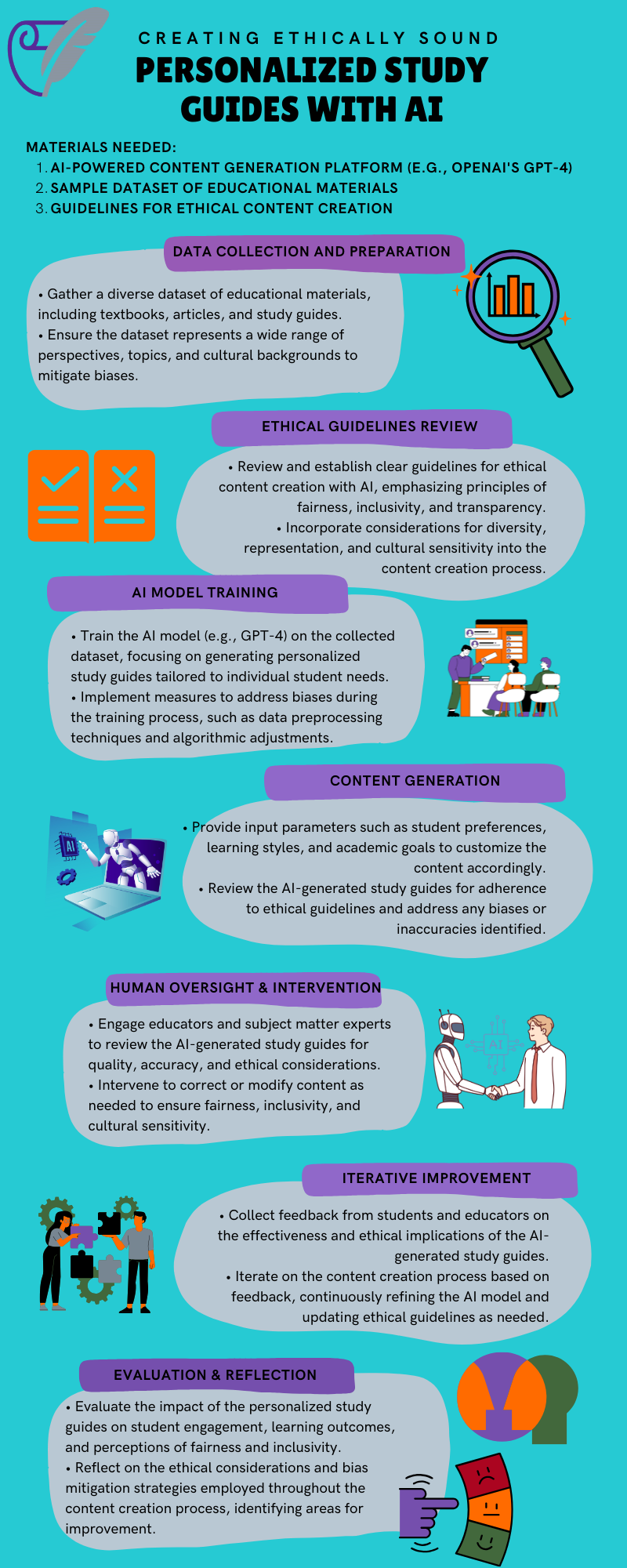Ethical Considerations and Bias Mitigation in AI
Ethical Considerations and Bias Mitigation in AI
Overview
As we explore the realm of personalized learning material creation powered by AI, it's essential to address the ethical considerations and biases inherent in this technology. While AI holds immense promise in revolutionizing education, its integration raises concerns regarding fairness, transparency, and privacy. This module explores strategies to mitigate biases, promote transparency, and uphold ethical standards in the development and utilization of AI-generated content for personalized learning experiences.
Learning Objectives:
- Understand the ethical implications of integrating AI into personalized learning material creation.
- Identify potential biases and privacy concerns associated with AI-driven educational content.
- Develop strategies to mitigate biases and promote fairness and inclusivity in AI-generated learning materials.
- Recognize the importance of human oversight and intervention in ensuring ethical AI practices in education.
- Evaluate the impact of AI-generated content on teaching and learning outcomes, considering factors such as fairness, transparency, and student engagement.
Ethical Concerns
- Bias Amplification: AI algorithms can inadvertently perpetuate and amplify biases present in the training data, leading to unfair treatment or discrimination against certain groups of students.
- Privacy Risks: The use of large datasets containing sensitive student information poses privacy risks, raising concerns about data security and unauthorized access.
- Dehumanization of Education: Over-reliance on AI for personalized learning may undermine the role of human interaction and personalized instruction, potentially dehumanizing the educational experience.
Mitigation Strategies
- Transparency and Accountability: Promote transparency in AI algorithms by disclosing the sources of training data, the underlying algorithms, and the decision-making processes. Establish mechanisms for accountability to ensure that AI-generated content aligns with ethical standards and educational objectives.
- Human Oversight and Intervention: Maintain human oversight throughout the content creation process to critically evaluate AI-generated materials for biases, inaccuracies, and ethical implications. Educators should intervene when necessary to correct or modify content to ensure fairness and inclusivity.
- Continuous Monitoring and Evaluation: Implement systems for continuous monitoring and evaluation of AI systems to identify and address biases, errors, or unintended consequences. Collect feedback from students and faculty to assess the impact of AI-generated content on teaching and learning outcomes, iterating based on insights gathered.
- Ethics Training and Awareness: Provide ethics training and awareness programs for faculty and students to educate them about the ethical implications of AI in education. Foster discussions about bias, fairness, and privacy to promote ethical decision-making and responsible use of AI tools.
- Data Governance and Privacy Protocols: Establish robust data governance and privacy protocols to safeguard sensitive student information and ensure compliance with relevant regulations, such as GDPR and FERPA. Implement encryption, access controls, and data anonymization techniques to mitigate privacy risks associated with AI-powered personalized learning.
Application Activity
Ethical Decision-Making Scenario Scenario: You are tasked with creating personalized study guides using AI for a diverse group of students. However, you notice that the AI-generated content tends to prioritize certain topics over others, potentially excluding important but less represented subjects.
Activity:
- Identify potential biases in the AI-generated content, considering factors such as representation, cultural relevance, and historical context.
- Discuss the ethical implications of bias in personalized learning materials, emphasizing the importance of fairness, inclusivity, and diversity.
- Brainstorm strategies to mitigate bias and promote fairness in the creation of personalized study guides, such as manual content curation, diversity audits, and stakeholder consultations.
- Develop guidelines for ethical content creation with AI, incorporating principles of fairness, transparency, and inclusivity.
- Reflect on the ethical considerations raised and propose recommendations for future improvements in AI-driven personalized learning material creation.
- Customized Learning Materials Creation
- Automated Assessment and Feedback
- Prompt Engineering
- Enhancing Research with Generative AI
- Language Learning and Enhancement
- Content Summarization and Analysis
- Ethical Considerations and Bias Mitigation in AI
- AI for Accessibility in Education
- Teaching Students How to Collaboratively Write wit…
- Shifting Student Mindsets in AI-Enhanced Learning
- BLOG: Educ-AI-tion Revolution
- Managing Integrity in the AI Transition
- Teaching Outside the Box: Integrating AI within a …
- Mastering AI Prompts

Key Takeaways & Resources
- Prioritize fairness, transparency, and inclusivity in AI-driven personalized learning material creation to mitigate biases and promote ethical practices.
- Maintain human oversight and intervention to critically evaluate AI-generated content for biases and inaccuracies.
- Implement continuous monitoring and evaluation systems to assess the impact of AI on teaching and learning outcomes, iterating based on feedback.
- Provide ethics training and awareness programs for faculty and students to foster responsible use of AI in education.
- Establish robust data governance and privacy protocols to safeguard sensitive student information and ensure compliance with relevant regulations.
For further guidance on ethical considerations and bias mitigation in AI for education, refer to the following resources:
- UNESCO's AI Ethics Guidelines for Education: Provides a comprehensive framework for addressing ethical challenges in AI-driven education, including principles, guidelines, and case studies.
- AI4ALL's Bias and Fairness Toolkit: Offers practical strategies and resources for identifying and mitigating biases in AI systems, tailored for educators and researchers.
- The IEEE Global Initiative on Ethics of Autonomous and Intelligent Systems: Offers a wealth of resources, including standards, publications, and toolkits, for addressing ethical concerns in AI across various domains, including education.
Conclusion
In navigating the terrain of AI-driven personalized learning material creation, it's imperative to confront ethical considerations and biases head-on. While AI holds tremendous potential to revolutionize education, its application must be tempered by a commitment to fairness, transparency, and inclusivity. By prioritizing human oversight, transparency, and continuous evaluation, educators can harness the power of AI while mitigating the risks of bias and discrimination. As we continue to innovate in the realm of personalized education, let us remain vigilant in upholding ethical standards, ensuring that technology serves as a catalyst for positive change in teaching and learning.
Page Options
